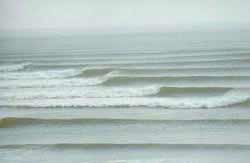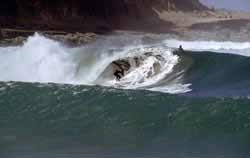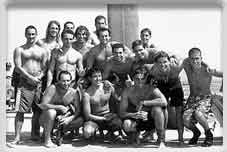SURFING PERU WITH PERU SURF GUIDES |
PERU SURF GUIDES  WHY YOU SHOULD COME WITH US?
WHY YOU SHOULD COME WITH US?  SERVICES AND RATES
SERVICES AND RATES  LEARN TO SURF IN PERU
LEARN TO SURF IN PERU  PERU SURF BEACHES
PERU SURF BEACHES  |

PERU SUFING HISTORY
 |
SURFING PERU SURF GUIDES |
PERU SURFING HISTORY, FISHING, SURFING, LIVING
THE BEGINNINGS OF SURFING IN ANCIENT PERU
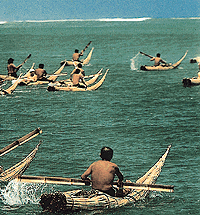 Traditionally,
the art of surfing is derived directly from the old members of the
Hawaiian royalty, who surfed on boards made by themselves from materials
locally available. The art of surfing was considered "the sport
of kings", and the major part of the contemporary history, frequently
based on studies made at the Bishop Museum of Hawaii, used to find
its origins at the blue waters of Oahu and its surrounding islands. Traditionally,
the art of surfing is derived directly from the old members of the
Hawaiian royalty, who surfed on boards made by themselves from materials
locally available. The art of surfing was considered "the sport
of kings", and the major part of the contemporary history, frequently
based on studies made at the Bishop Museum of Hawaii, used to find
its origins at the blue waters of Oahu and its surrounding islands.
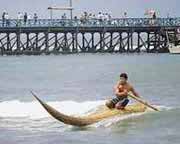 Nevertheless,
there are two ancient cultures, Mochica and Chimu, which developed
in the north of Peru more than two thousand years ago and were discovered
thanks to existence of important ruins and architectural complexes. Nevertheless,
there are two ancient cultures, Mochica and Chimu, which developed
in the north of Peru more than two thousand years ago and were discovered
thanks to existence of important ruins and architectural complexes.
These societies have been the first ones to be related actively with powerful tidal zones, through activities such as transport and fishing. They left us many examples of designs "featuring" waves in the religious iconography and the art expressed on textiles, frescos and ceramics, many of which are scale models of the first crafts made for surfing called "caballitos de totora". 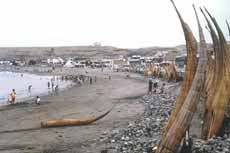 The
first men, who experienced the pleasure of surfing, were fishermen
who had to utilize the powerful waves in order to get food. The
necessary courage, in combination with the instinct of survival
resulted in a ritual similar to that of other warriors in history.
This was the earliest example of men using boards created specifically
for entering and leaving the sea. These men are still using them
in modern times. It is possible to watch them in Trujillo; Huanchaco
Beach is famous for this reason. The
first men, who experienced the pleasure of surfing, were fishermen
who had to utilize the powerful waves in order to get food. The
necessary courage, in combination with the instinct of survival
resulted in a ritual similar to that of other warriors in history.
This was the earliest example of men using boards created specifically
for entering and leaving the sea. These men are still using them
in modern times. It is possible to watch them in Trujillo; Huanchaco
Beach is famous for this reason. Because surfing was one of the most important parts in the learning process of every fisherman, the success of the daily catch depended on complete knowledge of the waves and the ocean. PERUVIAN SURFING IN MODERN TIMES 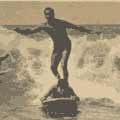 Even if its true that Carlos Dogny took the first modern surfboard from Hawaii and imposed a way of surfing completely different than the one practiced on Peruvian coasts on "caballitos de totora", it is also true that before its miraculous appearance in the sea of Miraflores, the people from Lima had developed their own way of surfing. In an article published in the newspaper "El Comercio" on Sunday 28th of February of 1960, it stated: Even if its true that Carlos Dogny took the first modern surfboard from Hawaii and imposed a way of surfing completely different than the one practiced on Peruvian coasts on "caballitos de totora", it is also true that before its miraculous appearance in the sea of Miraflores, the people from Lima had developed their own way of surfing. In an article published in the newspaper "El Comercio" on Sunday 28th of February of 1960, it stated:
"The origins of this activity in Peru can be found in what our water sport people call "riding waves". It was then, by 1909, that the group conformed by Alfonso and Alfredo "Shark" Granda Pezet, the old Buzzaglo, Celso Gamarra, the "Gringo" Schoeder and Alfonso Cillóniz, among others, resolved "riding waves" using a drawing board, in front of the beaches of Barranco. A little bit later, they were replaced by table boards". Carlos Dogny was a globetrotter, playboy and sportsman who circled the globe 39 times. One of his favorite sports was polo, and thanks to this, he was invited to visit Hawaii. There he learned to surf, the traditional sport of kings and military chiefs, with the Ambassador of Modern Surfing, Duke Kahanamoku. He named it "tabla hawaiana" (Hawaiian board), and the name still holds in Peru. It required a lot of physical strength, because at that time boards were 5 to 6 meters long, of solid wood and a weighed 100 kilos. 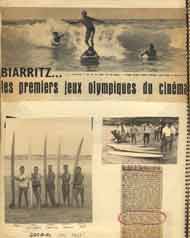 During his studies in New York, the Second World War began in Europe. Even though he was a Peruvian citizen, he could have been sent to war, because he lived in the USA. To avoid this, he chose the place he found more secure and pleasant: Hawaii. But once there, he had the feeling that his life was in danger, because the war expanded all over the world and there was war between Japan and the USA. Due to the turmoil, he came back to South America, bringing with him by ship, one of those big boards with the remote hope to find an appropriate place to practice. When he arrived to Lima he started to study the sea and found in Miraflores, waves that he considered appropriate. Sure enough, the waves proved adequate for his practices. Later on, curious swimmers came close to him while he surfed, and he taught them this new sport. Such was the interest they showed, that the most enthusiastic ones begun to produce their own boards made of wood in workshops and garages. Since there was no place to leave the boards after surfing, the famous Waikiki Club in the "Costa Verde" (Green Coast) of Miraflores was established. He also was an important member in the creation of the first French surf club. During his studies in New York, the Second World War began in Europe. Even though he was a Peruvian citizen, he could have been sent to war, because he lived in the USA. To avoid this, he chose the place he found more secure and pleasant: Hawaii. But once there, he had the feeling that his life was in danger, because the war expanded all over the world and there was war between Japan and the USA. Due to the turmoil, he came back to South America, bringing with him by ship, one of those big boards with the remote hope to find an appropriate place to practice. When he arrived to Lima he started to study the sea and found in Miraflores, waves that he considered appropriate. Sure enough, the waves proved adequate for his practices. Later on, curious swimmers came close to him while he surfed, and he taught them this new sport. Such was the interest they showed, that the most enthusiastic ones begun to produce their own boards made of wood in workshops and garages. Since there was no place to leave the boards after surfing, the famous Waikiki Club in the "Costa Verde" (Green Coast) of Miraflores was established. He also was an important member in the creation of the first French surf club.
FELIPE POMAR, FIRST WORLD SURFING CHAMPION In the summer of 1965, when the First World surfing Championship was held, Punta Rocas was a relatively new point break. The day the championship began, it was foggy with big waves. It was impossible to see the waves but a constant roar could be heard. When the fog lifted everybody was surprised by the size of the waves. These conditions favored the surfers accustomed to big waves. Among them was Felipe Pomar, who is with DUKE KAHANAMUKU in that picture, he already had two years of experience surfing in Hawaii. 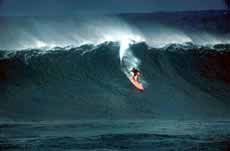 He remembers having been the only Peruvian in the finals, and he said to himself: "being already in the finals is OK, now search for bigger waves and risk everything. Nobody has trained more than you, nobody sacrificed himself more, and nobody deserves it more than you". He almost drowned because he didn't leave his board (leash less at that time) in a wipeout riding a left. Leaving the sea after the Finals many people came down the hill and exclaimed: ´´¡You won, you won!" He didn't believe them until the results were announced and he was carried away on their shoulders. He remembers having been the only Peruvian in the finals, and he said to himself: "being already in the finals is OK, now search for bigger waves and risk everything. Nobody has trained more than you, nobody sacrificed himself more, and nobody deserves it more than you". He almost drowned because he didn't leave his board (leash less at that time) in a wipeout riding a left. Leaving the sea after the Finals many people came down the hill and exclaimed: ´´¡You won, you won!" He didn't believe them until the results were announced and he was carried away on their shoulders.
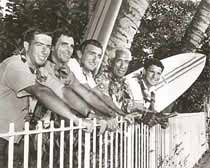 However, his most memorable adventure was with Pitty Block when
they entered the sea to surf after the 1974 earthquake. It lasted
approximately two minutes and they entered the sea around "La Isla"
(the Island) of Punta Hermosa with the idea of surfing whatever
the ocean could produce. They did not count that the sea would retire
and draw them back, which indeed happened. After living through
some really terrific moments, they were able to cross the bay and
catch a wave each; both of which were deemed "Tsunamis".
However, his most memorable adventure was with Pitty Block when
they entered the sea to surf after the 1974 earthquake. It lasted
approximately two minutes and they entered the sea around "La Isla"
(the Island) of Punta Hermosa with the idea of surfing whatever
the ocean could produce. They did not count that the sea would retire
and draw them back, which indeed happened. After living through
some really terrific moments, they were able to cross the bay and
catch a wave each; both of which were deemed "Tsunamis". THE DEVELOPMENT OF SURFING IN PERU 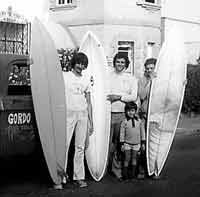 Peruvian surfing began, developed and thrived in "Costa Verde", but with an ever increasing talent and hunger, the growing number of adventure-surfers discovered new and powerful waves such as Kon Tiki, Punta Rocas, Pico Alto and Cerro Azul in the south, and Chicama, Pacasmayo, Cabo Blanco, Panic Point, Lobitos, among others in the north. The Peruvian coast is 3079,5 Km. from north to south and it is constantly receiving powerful swells during the entire year, however during the winter swells are more frequent. Nowadays surfing is being practiced all over the country: on the north coast, where some of the most perfect waves can be found, in the northern villages of Lima where there are many uncrowded and quality beaches, in Lima, where the surf is more extended and different waves break in close proximity to each other, and finally in the south of Peru, where the waves are heavy, the weather is colder, and there are many beaches yet to be surfed. Peruvian surfing began, developed and thrived in "Costa Verde", but with an ever increasing talent and hunger, the growing number of adventure-surfers discovered new and powerful waves such as Kon Tiki, Punta Rocas, Pico Alto and Cerro Azul in the south, and Chicama, Pacasmayo, Cabo Blanco, Panic Point, Lobitos, among others in the north. The Peruvian coast is 3079,5 Km. from north to south and it is constantly receiving powerful swells during the entire year, however during the winter swells are more frequent. Nowadays surfing is being practiced all over the country: on the north coast, where some of the most perfect waves can be found, in the northern villages of Lima where there are many uncrowded and quality beaches, in Lima, where the surf is more extended and different waves break in close proximity to each other, and finally in the south of Peru, where the waves are heavy, the weather is colder, and there are many beaches yet to be surfed.
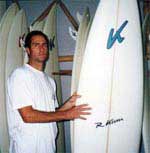 The
Peruvian sea has different types of waves for surfing: big, small,
tubular, shore breaks, long and powerful waves. All of them require
different kinds of boards. Those boards made by Peruvian shapers
enjoy the highest reputation, not only in Peru but also in foreign
countries, where they have been tested in demanding waves. They
are being imported by many Latin-American countries. The
Peruvian sea has different types of waves for surfing: big, small,
tubular, shore breaks, long and powerful waves. All of them require
different kinds of boards. Those boards made by Peruvian shapers
enjoy the highest reputation, not only in Peru but also in foreign
countries, where they have been tested in demanding waves. They
are being imported by many Latin-American countries. 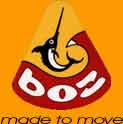  The
first surfers to be professionally engaged in this activity were
"Gordo" Barreda, Wayo Whilar (who has built surfboards since 1966),
among others. Nowadays, there are many places where surfboards are
being made, especially in the Lima area. Surfboards there are made
to order or can be bought from stock, suitable for the Peruvian
coast. The
first surfers to be professionally engaged in this activity were
"Gordo" Barreda, Wayo Whilar (who has built surfboards since 1966),
among others. Nowadays, there are many places where surfboards are
being made, especially in the Lima area. Surfboards there are made
to order or can be bought from stock, suitable for the Peruvian
coast. 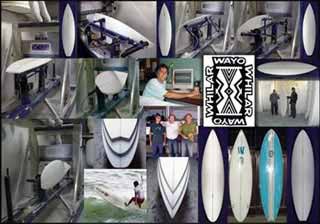 Among
the most outstanding shapers for their design and quality are Rodolfo
Klima (Klimax surfboards), Alfredo Tello (Swells surfboards), Ricky
Peschiera (OX surfboards), and Milton and Wayo Whilar. Klimax and
Wayo Whilar surfboards also produce computer designed surfboards,
which satisfies the increasing demand of the Peruvian surfing market.
In addition, Ricardo Buroncle owner of Boz wetsuits are nationally
and internationally known for their materials used to thwart the
cold winter, and maintain the flexibility of the surfer. Among
the most outstanding shapers for their design and quality are Rodolfo
Klima (Klimax surfboards), Alfredo Tello (Swells surfboards), Ricky
Peschiera (OX surfboards), and Milton and Wayo Whilar. Klimax and
Wayo Whilar surfboards also produce computer designed surfboards,
which satisfies the increasing demand of the Peruvian surfing market.
In addition, Ricardo Buroncle owner of Boz wetsuits are nationally
and internationally known for their materials used to thwart the
cold winter, and maintain the flexibility of the surfer. PERUVIAN SURF SCHOOLS  One of the most important developments in Peru surfing history is the SURF SCHOOL, OLAS PERU. It was one of the first surf schools in Peru and began in 1992 in Punta Hermosa with 5 kids. One of those kids was Sofia Mulanovich. The founder Roberto "MUELAS" Meza started his lessons in Punta Hermosa and the school has since become a nest for many Peruvian surfers of the new generation. Luis Miguel de la Rosa, also known as "MAGOO", is the former seven time national champion and has been another important icon in Peruvian surf schools. Also formers champions, as Carlos "CHALO" Espejo, and Rocio Larrañaga are teaching and sharing their experience to anyone who wants to learn to surf. One of the most important developments in Peru surfing history is the SURF SCHOOL, OLAS PERU. It was one of the first surf schools in Peru and began in 1992 in Punta Hermosa with 5 kids. One of those kids was Sofia Mulanovich. The founder Roberto "MUELAS" Meza started his lessons in Punta Hermosa and the school has since become a nest for many Peruvian surfers of the new generation. Luis Miguel de la Rosa, also known as "MAGOO", is the former seven time national champion and has been another important icon in Peruvian surf schools. Also formers champions, as Carlos "CHALO" Espejo, and Rocio Larrañaga are teaching and sharing their experience to anyone who wants to learn to surf.
Thanks to our waves, our history and the phenomenon of Sofia M, Peru has many surf schools which are still growing. It does not matter what time of year, the amount of kids in the water is rising, boys and girls, young and old.
SOFIA MULANOVICH, ASP WORLD CHAMPION 2004, ACTUALLY RANKING #1 IN THE WORLD 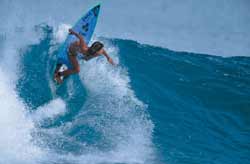 Sofia
Mulanovich started to surf when she was a little girl at Máncora
beach in northern Peru. She continued practicing at her local beach,
Punta Hermosa, and was always supported by a family in which everyone
practiced the sport. Given her talent since her early days, she
was trained by Magoo de la Rosa, and also by Roberto Meza, National
Champion 1991 and Director of the oldest Surf School in South America. Sofia
Mulanovich started to surf when she was a little girl at Máncora
beach in northern Peru. She continued practicing at her local beach,
Punta Hermosa, and was always supported by a family in which everyone
practiced the sport. Given her talent since her early days, she
was trained by Magoo de la Rosa, and also by Roberto Meza, National
Champion 1991 and Director of the oldest Surf School in South America.
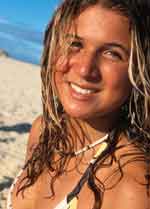 Sofia
conquered easily since her early age in the Ladies Championships,
which made her try her luck in competing against boys of her age
where she frequently won, showing quality, and a solid and perfect
style in her surfing, visioning her future stardom as a professional
surfer. She took part in International Events since she was 13 years
old, acquiring this way the necessary level a surfer of her quality
had to have in order to challenge what her surfing would allow her:
being the World Champ. Her sponsors are Roxy, Channel Island surfboards,
LAN airlines, Red Bull, Ripley, Movistar and Reef. Her most important
triumphs have been four times as National Champion (1996-1999),
Panamerican Champion 1998, ISA World Champion 2004, five victories
in the World Professional Championship Tour WCT and the World Professional
Championship 2004. Actually, she's ranked first after her recent
victory in the WCT event in Fiji, Tavarua. Sofia
conquered easily since her early age in the Ladies Championships,
which made her try her luck in competing against boys of her age
where she frequently won, showing quality, and a solid and perfect
style in her surfing, visioning her future stardom as a professional
surfer. She took part in International Events since she was 13 years
old, acquiring this way the necessary level a surfer of her quality
had to have in order to challenge what her surfing would allow her:
being the World Champ. Her sponsors are Roxy, Channel Island surfboards,
LAN airlines, Red Bull, Ripley, Movistar and Reef. Her most important
triumphs have been four times as National Champion (1996-1999),
Panamerican Champion 1998, ISA World Champion 2004, five victories
in the World Professional Championship Tour WCT and the World Professional
Championship 2004. Actually, she's ranked first after her recent
victory in the WCT event in Fiji, Tavarua.
|
PERU SURF GUIDES SERVICES AND RATESWe can arrange the perfect surf trip for you and your mates.TAKE A LOOK!
|


